Much like a favorite pair of boots we pull on every day but can’t recall the last time we cleaned and oiled, farm skid and small oscillating loaders are so useful we use them for everything from cleaning pens to moving feed. For most of us, it is a rare day someone does not use the skid loader for some task, big or small.
It is hard to imagine how we got along without these handy little workhorses. In many instances, they make it possible for one person to quickly and efficiently perform the tasks that previously required multiple people.
The downside of this is: Much like the well-fitting old boots, hours of use rack up day after day and, before we realize it, these machines are seriously overdue for regular maintenance and care. Because some of the maintenance required for skid loaders requires time and meticulous detail, it is a good idea to schedule time between major events in a given year to work on maintenance on these machines.
Gregory Eppich of Eppich Farms, Handel, Saskatchewan, Canada, says, “We spend the summer months farming, harvesting crops and tending to a small herd of cattle. Winter finds us shipping grain, feeding cattle and maintaining equipment, among other chores. Hardly a day goes by one of us isn’t using the skid loader for something.
We try to keep up on oil and filter changes based on the hours of use, but sometimes other things get neglected. I couldn’t tell you how many times I’ve stopped and greased the loader because of a bad squeak and wondered how long it had actually been since I greased it last.”
Eppich explains that, with harvest winding down, he will begin “going through the machinery.” First, he plans to service the machines he will continue to use through the fall and winter months – skid loaders, tractors, trucks and augers. Later, he will work his way to the planting and harvesting machinery needed next year.
Not long ago, I noticed a few issues developing with my skid loader and contacted an old friend, Daryl Watson, who worked as a service tech for New Holland near Dillon, Montana for many years. Watson reinforced the importance of safety when servicing skid loaders, reminded me of areas on skid loaders that need periodic adjustment and helped troubleshoot the issues with my machine.
Safety
One of the aspects of skid loaders that make them so versatile is their low center of gravity, but this makes some service difficult. These machines are designed with a thick belly pan to prevent damage from rocks and other solid objects the operator may drive over. To allow for draining the engine and hydraulic fluids, the designers constructed removable access ports in the belly pan.
On many of these machines, it is very difficult to access these ports without raising the machine a few additional inches above the ground. It can be difficult and unsafe to jack up the machine. A safe method to elevate the machine the necessary distance is to use boards or planks to create platforms you can safely drive the skid loader onto.
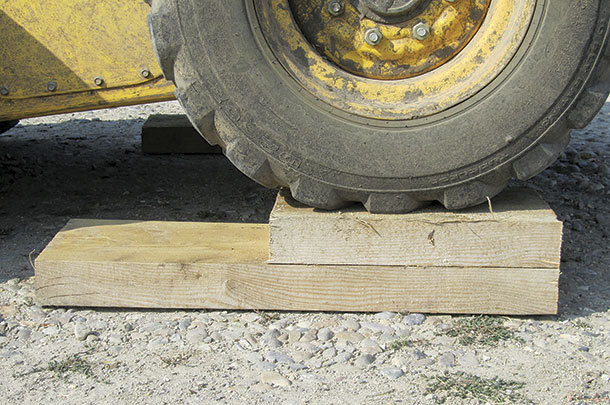
To maximize stability, do not attempt to raise the machine higher than a distance necessary to access the port and drain plug. Once you have determined the distance of lift needed, use planks or boards in a combination of lengths to allow you to drive onto the platform easily.
To ensure this platform is stable, screw each layer of plank or board securely to the plank or board below it. I used 3-inch-by-10-inch rough-cut planks to create my platforms. I cut the first plank 2.5 feet long and the last plank in the platform 1.5 feet long. I configured the longer plank on the bottom and stair-stepped the shorter plank on top.
A skid loader will have no problem climbing 3 inches, but if you combine all of the boards together at the same length, it will be very difficult and unsafe to attempt to climb the skid loader onto the planks.
Most service of the engine and other systems can be performed with the loader boom on or near the ground. Skid loaders become more unstable and more prone to overturning the higher the loader boom is raised above the ground. While the loader is sitting on platforms or ramps, perform all service with the loader boom down.
If you must perform service with the loader boom raised, drive the skid loader off of the platforms.
NOTE: Be sure you have the proper tools on hand to perform the service required. Because of the lack of clearance between the belly pan and the engine oil pan, many skid loaders have flat-style drain plugs with inset tooling to receive a Torx head or Hex head driver. Use of the improper style or size tool will damage the plug.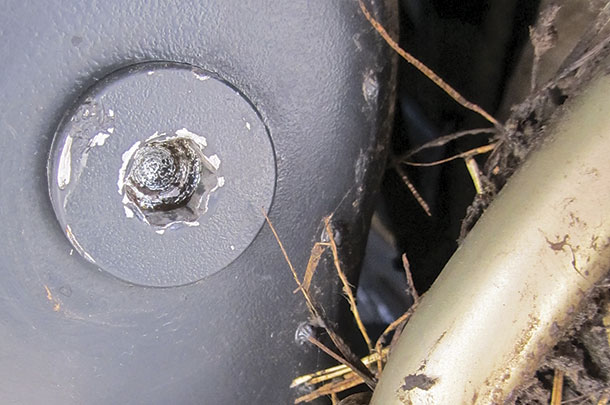
Commonly neglected areas
Watson says, “It is a good idea to refer to the operating manual of your skid steer when maintaining the machine. While much of the service required is very straight-forward, types and quantities of lubricants, and special areas of necessary maintenance and adjustment are not always obvious.”
Most grease points on the loader boom and attachments are easily visible, but points on the body of the machine may not be visible. Many skid loaders have a grease zerk on the axle bearing that cannot be accessed without removing the tire.
The recommended interval for greasing may be as much as 1,000 hours, but in ranch and dairy applications – where skid loaders are used around bale twine or net wrap – it is advisable to remove the tires more often to remove the twine or net wrap in order to prevent heat collection around the axle-bearing seals.
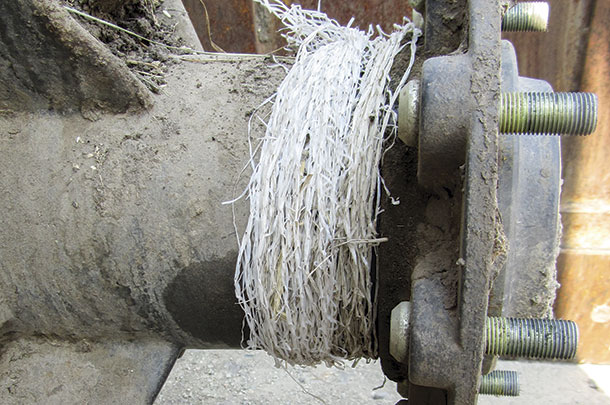
While most of us are good about checking the oil in the engine and hydraulic systems, it is easy to neglect the final drive chain case.
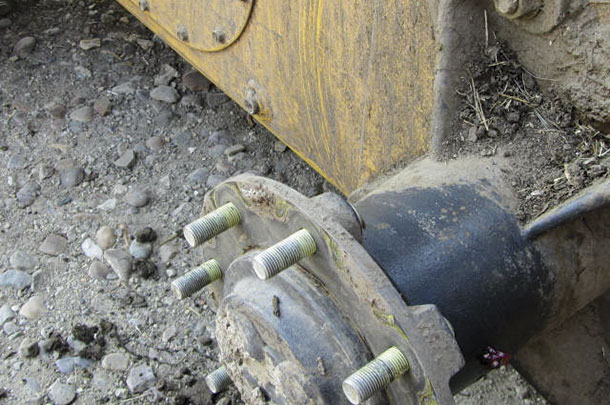
With the machine on flat ground, remove the plug on the side of each final drive chain case and check the level of the fluid.
This fluid needs changed at recommended intervals, depending on the make and model of your machine. Also, be aware the final drive chains wear and stretch over time, and it is very important to maintain the correct chain tension to avoid serious damage to the drive system of the skid loader. This maintenance is performed by accessing the chain through the large access panel on the side of the final drive chain case.
Some models use mechanical linkages to control machine movement and loader boom function. These linkages are located under the seat and require occasional lubrication to operate properly.
Skid loaders used on ranches and dairies are also prone to manure and dirt collection on and around hard-to-reach areas. It is important to power wash wheels, axles and the undercarriage periodically to remove this source of corrosion.
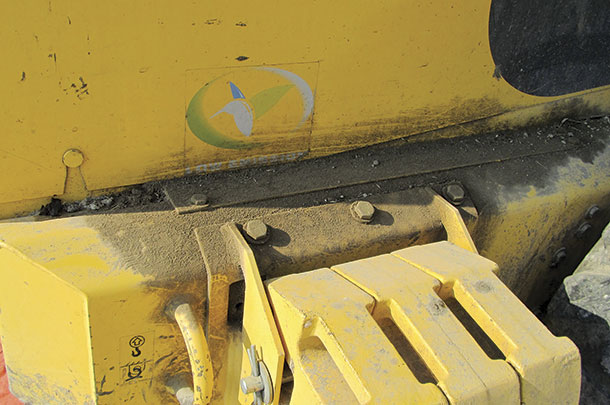
Eppich stresses the importance of cleaning the skid loader periodically. “In the process of a regular cleaning program, you may find minor structural cracks to the skid loader body and loader boom before they become serious and can still be repaired easily. Also, minor oil leaks can be detected and remedied before they disable the machine.”
While looking for structural damage and leaks, it is a good idea to check the exhaust system.
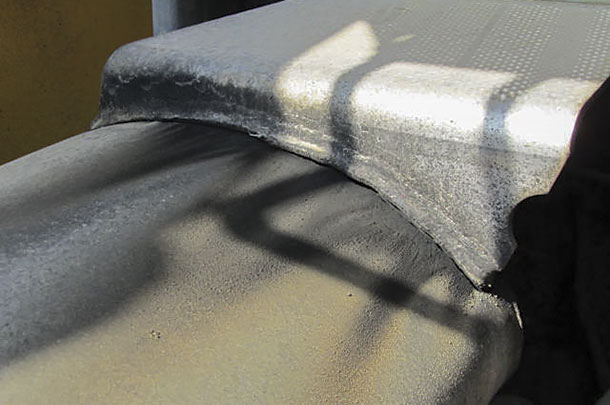
The exhaust system is designed to deliver the engine exhaust away from the operator, but if the system develops a crack or break, it can cause the exhaust to be delivered to the cab and be very harmful to the operator.
One final tip: Keep skid loader tires inflated to the maximum pressure rated for the tire. These tires are designed to be run tubeless and can be difficult to keep inflated. These tires have a thick and stiff sidewall and may slowly leak air, and as the pressure drops, they will lose air more rapidly.
If you are having trouble with this, try adding industrial tire slime. If the problem persists, add a tube, but beware: Once you add a tube, you will no longer be able to fix a nail puncture with a plug. ![]()
PHOTO 1: A safe platform can be made from two 3-inch-by-10-inch rough-cut planks screwed together to prevent movement.
PHOTO 2: An engine oil drain plug is fouled by the use of an incorrect tool to remove the plug.
PHOTO 3: Round bale net wrap collected around this axle, but it was not readily visible behind the tire.
PHOTO 4: Shown here are the final drive chain access panel (left side), final drive chain oil check plug (center) and axle-bearing grease zerk (right side).
PHOTO 5: The dirt collected below the engine cover revealed a leaking hydraulic reservoir behind the cover.
PHOTO 6: This exhaust muffler is cracked at the mounting bracket due to vibration. Photos by Michael J. Thomas.
Michael J. Thomas is a freelance writer. Email Michael J. Thomas.











